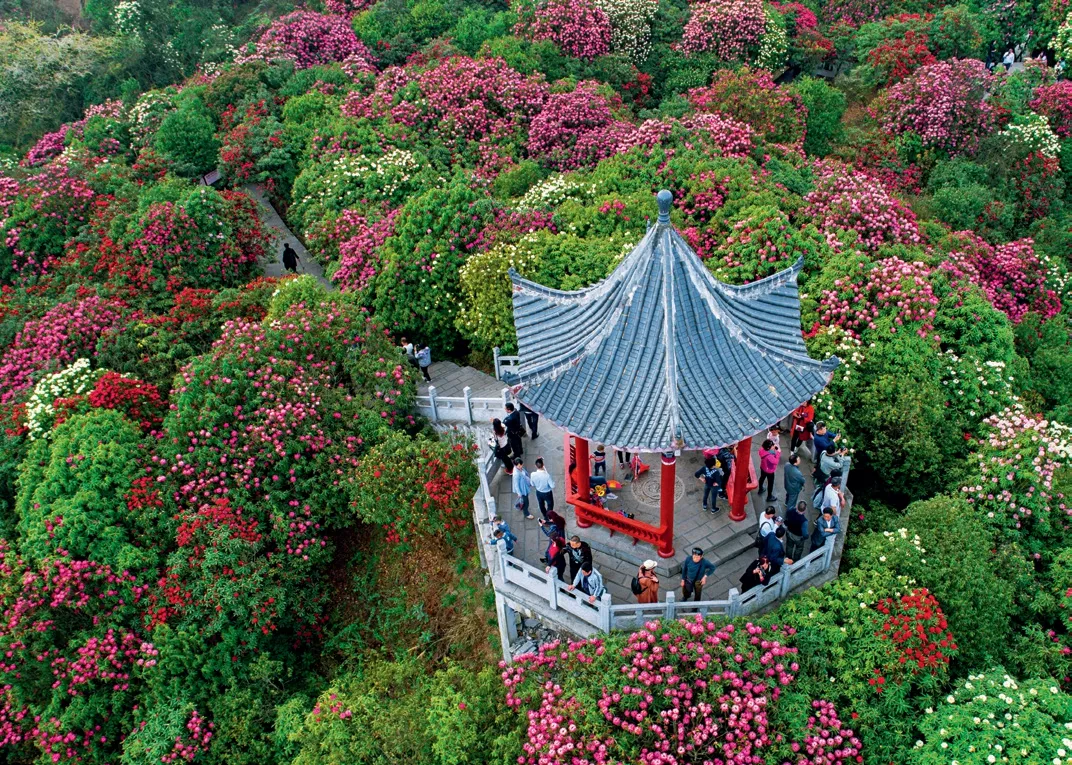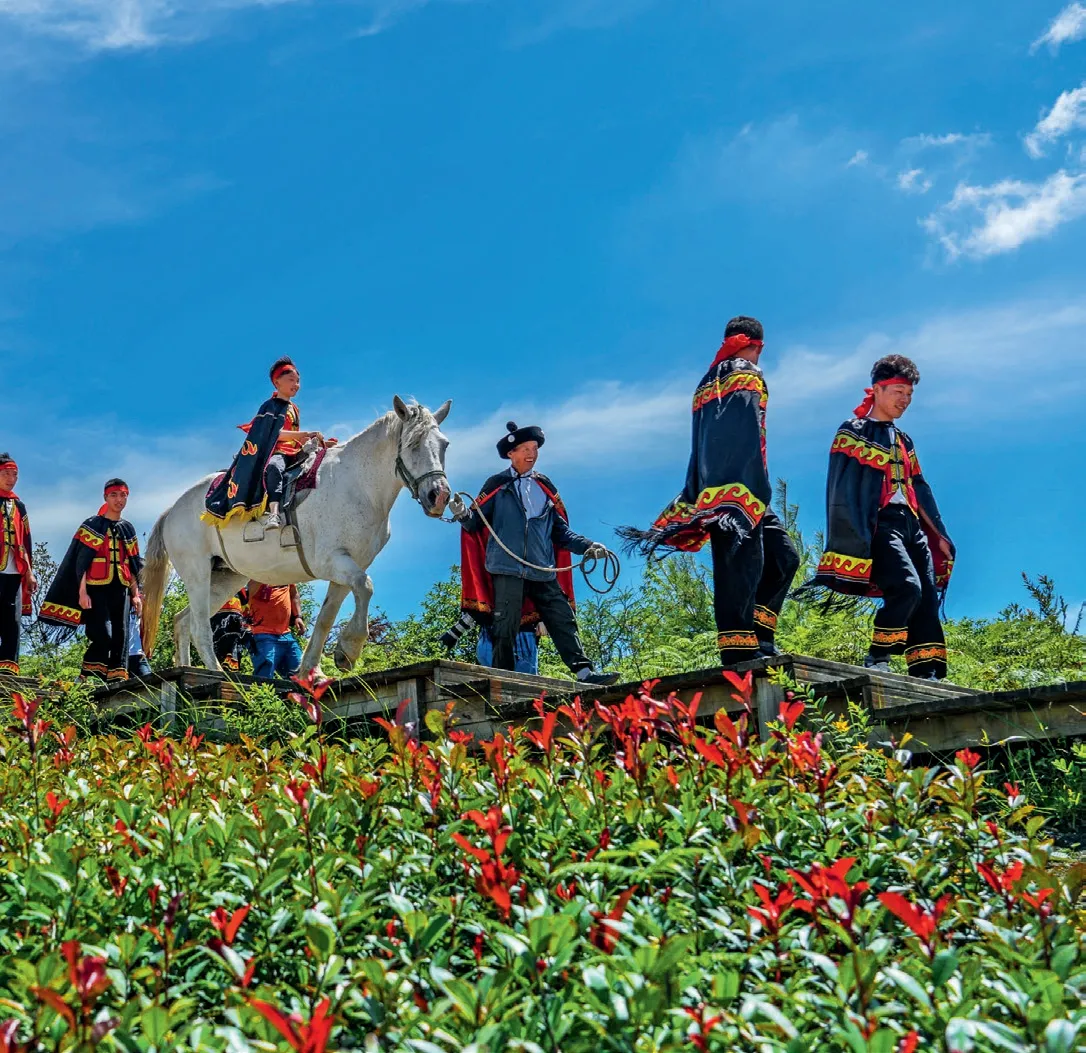Savoring a Sea of Flowers
By sbo reporter MENG JAXIN

Visitors are enjoying views of rhododendrons in full bloom at the Jinpo scenic area in Qianxi City of southwest China’s Guizhou Province.
EVERY summer, the mountains in southwest China’s Guizhou Province are transformed into a sea of rhododendrons, creating a spectacular scenery that attracts visitors from all over the country.
One of the best places to view the enchanting sight is the Baili(hundred miles) Rhododendrons Scenic Area in Bijie, a city in northwestern Guizhou.In this around 550 sq km area, you can find over 60 species of rhododendrons.The area houses a national forest park and a national nature reserve and has been recognized as a national 5A tourist attraction, the top state recognition.
It is also a well-preserved primitive rhododendron forest, the largest known rhododendron forest with the most varieties identified,and the only national rhododendron forest park in the world.It has the most identified varieties of the flower as well as over 130 species of birds and beasts and a similar number of fungi.The fauna includes the clouded leopard and pangolin, which are wildlife under state protection, as well as protected plants such as gingko andTaxus chinensis.The climate is another attraction, neither too cold nor too hot, which makes it the perfect place to live in or visit.
Baili Azalea Scenic Area consists of two core areas: Pudi Scenic Area and Jinpo Scenic Area.
Pudi Scenic Area
Electric buses are available for tours.As you go past the gates,large azaleas greet you while green woods beckon.
A four-story classic pavilion,Wanhualou stands out in the sea of flowers, offering a panoramic view of the entire area.The undulating sea of red, pink, and white blossoms is complemented by green fields, cyan mountains, and quaint village houses with white walls and dark tiles.
The Wucai Path and Yuntai Ridge are some of the vantage points here, with a perfect view.The Yuntai Ridge is covered with clouds.Everytime it drizzles, the trees are mist-shrouded, looking ethereal.In the west, a line of round stones stands out among the trees.
The Shuhua Peak is the summit of this area, offering the most commanding position.A stone here looks like one of the imperial bulletin boards to show the name list of people who passed the imperial exam in the past.Local people would often come here to wish for good luck in the imperial examinations.
Zuijiuniu, a scenic spot in the area, has a legend behind its name.In the Ming Dynasty (1368-1644),a visionary tribal leader, Lady Shexiang, was said to have been traveling to the royal palace to pay tributes to Emperor Zhu Yuanzhang.On her way to the palace,the herd of cattle she was driving was captivated by the rhododendrons and became drunk with the smell of the flowers.This gave rise to the name Zuijiuniu, meaning the place where nine oxen got drunk.
The Red Army Square is a tribute to the Huangjiaba Battle.It marks the spot where the Red Army fought a heroic battle in February 1936 during the Long March.To commemorate the sacrifice of the fallen soldiers, the Red Army,and local people of all ethnic groups, the square was built in 2011.
panoramic
A four-story classic pavilion, Wanhualou stands out in the sea of flowers,offering a panoramic view of the entire area.
Jinpo Scenic Area
The Suoma Suspension Bridge,running between two mountains and surrounded by large swaths of flowers, is the most popular site in the Jinpo Scenic Area.Tourists swarm the bridge to take pictures.So, for safety reasons,the number of people who can be on the bridge at the same time is limited.

A bird’s-eye view of the gorgeous Baili(hundred miles)rhododendrons.

People of the Yi ethnic group hold a torch lighting ceremony at Baili rhododendrons scenic area in Bijie on July 22, 2022.
The bridge leads to the Mayingshan Rhododendrons Sea,where Rhododendron delavayi Franch, whose scarlet flowers are likened to red tassels on the heads of horses (Maying in Chinese), grow exuberantly.Legend has it that in the past, coal was abundant here, and would be carted away by horses.Once some horses accidentally shook off the red tassels on their heads.They fell among the trees and turned into rhododendrons as red as charcoal fire.This area is mainly a wild natural forest, and the trees are tall and bushy, bearing hundreds of flowers each.
The town of Baihuaping hosts the Flower Festival of the Yi ethnic group and the Tiaopo Festival of the Miao ethnic group every year.There’s a huge God of Flower statue, a theme park for a temple worshipping the God of Flower.Every floral season, locals burn incense in the temple and make offerings to pray for good weather.With people dressed in the colorful ethnic Yi and Miao clothes and singing and dancing among the azaleas, it’s a spectacular sight.
A nine-meter-high white marble statue stands at the Flower God Worshipping Square of the Jinpo Scenic Area.It is the statue of Somawei, the Yi people’s most beloved azalea goddess.Every year, there are ceremonies held to worship her.
Jinjiqing is a paradise not only of azaleas, but also the golden pheasant, a protected species.The rich humus in the soil makes it ideal for growing theGastrodia elata, a Chinese medicinal plant.It is also home to a sweet, refreshing tea called Jiu Long Shen Cao, which the Yis often serve to guests.
Cultural Legacies
In addition to the natural beauty, the area also boasts the ruins of an ancient plank road and the ancient courier stations of the Ming Dynasty, both of which are associated with Lady Shexiang.As the governor of Guizhou in the Ming Dynasty, she built roads, set up courier stations, expanded the local transportation network and promoted the social, economic and cultural development of Guizhou.She is regarded as having made great achievements in maintaining national unity and solidarity.
In order to keep close contact with the imperial court and develop local economy, she built a postal road from Guiyang in the east to Bijie in the west of the province.It is said that during an inspection tour, when Lady Shexiang passed through the Shuixi Courier Station, she learned that the Yi lacked convenient transportation.She immediately decided to build a road and assigned an attendant to cooperate with the local tribes.The road she built was 280 km long, with nine courier stations along the way.
At that time, it was almost a miracle for a woman to lead such a big project.What was more amazing was that the route of the road was almost the same as of the National Highway 321 built hundreds of years later.
A site named Longchang Jiuyi is a tribute to her and her project.
The Baili Rhododendron Scenic Area is in full bloom from March to May.So come and visit the enchanting scenery, made even more colorful by the local ethnic cultures.

